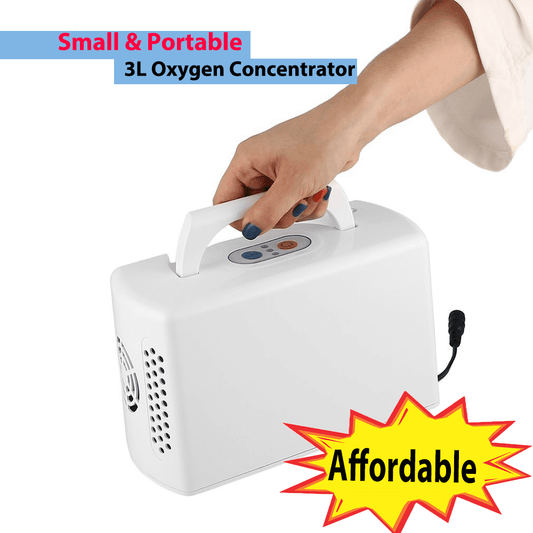Many people who use oxygen therapy often have such doubts: "How much oxygen flow should be adjusted? Is the higher the oxygen flow, the better?" It is certain that the higher the oxygen flow, the better, so let's learn about oxygen flow.
What is oxygen flow?
Oxygen flow refers to the oxygen flow rate of the oxygen concentrator per minute.
There are 1L/3L/5L/10L oxygen concentrators on the market. These different numbers represent the oxygen flow rate of the oxygen concentrator per minute.
N-liter oxygen concentrators can only adjust their maximum oxygen flow to N liters per minute when the oxygen concentration reaches more than 90%. When the oxygen flow rate is adjusted to exceed the maximum oxygen flow rate, the oxygen concentration decreases.
Teach you to see different oxygen flow rates
Low-flow oxygen inhalation
Usually refers to the oxygen flow rate set at 1-2L/min, which is suitable for patients with mild hypoxia. The advantage of low-flow oxygen inhalation is that the patient is more comfortable, less irritated, and the two nostrils can be used alternately.
Medium flow oxygen inhalation
The oxygen flow rate of medium flow oxygen inhalation is generally 2-4L/min, which is suitable for patients with moderate hypoxia. Compared with low flow oxygen inhalation, medium flow oxygen inhalation provides a higher amount of oxygen, but it is still necessary to ensure the patency and comfort of the patient's respiratory tract.
High flow oxygen inhalation
The oxygen flow rate of high flow oxygen inhalation is usually 4-10L/min, which is suitable for patients with severe hypoxia. High flow oxygen inhalation can provide a higher amount of oxygen, which helps to quickly improve the patient's hypoxemia.
In short, the higher the oxygen flow rate, not the better.
The oxygen flow rate needs to be adjusted according to the doctor's advice. The correct oxygen flow setting can ensure that the patient gets enough oxygen, thereby avoiding hypoxemia or hypoxia and ensuring that the patient gets the best treatment effect.

What is the difference between home oxygen concentrators and medical oxygen concentrators❓
There are significant differences between home oxygen concentrators and medical oxygen concentrators in terms of scope of application, product attributes, appearance design, oxygen concentration, use time, safety factor, noise level and other aspects. These differences reflect their different uses and design purposes to meet the needs of different users.
1. Scope of application
Household oxygen concentrator: usually used for daily health care, such as improving sleep quality, relieving altitude sickness, and improving work efficiency. It is suitable for ordinary families and individuals without medical needs.
Medical oxygen concentrator: specially designed for medical treatment, suitable for patients who need long-term or short-term medical oxygen therapy, such as patients with chronic obstructive pulmonary disease (COPD), patients with cardiovascular and cerebrovascular diseases, etc.
2. Product attributes
Household oxygen concentrator: The household oxygen concentrator is easy to use, light to move, has low power consumption, low noise, low pressure, fast oxygen production, and small gas production; it is suitable for use by the elderly, children, pregnant women and other groups, and is suitable for 1-2 people.
Medical oxygen concentrator: Medical oxygen concentrators are generally large in size, require a separate machine room, and have fire separation requirements from the living area.
3. Appearance design
Household oxygen concentrator: generally small in size, light in weight, easy to carry and move, no humidification bottle is required, and can be directly connected to the oxygen tube for use.
Medical oxygen concentrator: large in size and complex in structure, it is usually necessary to install a humidifier bottle at the oxygen outlet to improve the comfort of oxygen.
4. Oxygen concentration
Household oxygen concentrator: The oxygen concentration provided is usually unstable, and the oxygen concentration changes with the flow rate. The oxygen concentration of most household oxygen concentrators is 30-90%.
Medical oxygen concentrator: The oxygen concentration provided is usually stable at more than 90%, which can meet the requirements of medical treatment.
5. Use time
Household oxygen concentrator: The continuous working time is short, and it is necessary to stop using it in time to protect the machine.
Medical oxygen concentrator: It can work continuously for more than 24 hours to meet the needs of long-term treatment.
6. Safety factor
Household oxygen concentrator: It usually has basic safety protection measures, but the complexity is relatively low compared to the medical level.
Medical oxygen concentrator: It is equipped with professional gas monitoring and alarm devices, which has a high safety guarantee.
7. Noise level
Household oxygen concentrator: The noise level is generally less than 50 dB, and the comfort level is low.
Medical oxygen concentrator: Strictly control noise, especially when used at night, low noise is required so as not to affect the patient's rest.
8. Service life
Home oxygen concentrator: The service life is relatively short, and it can work for more than 30,000 hours in total.
Hospital oxygen concentrator: Long service life, can be used for many years, and has stronger durability.
Where Can I Buy Suitable Oxygen Concentrators?DEDAKJ Official Website
click the links below
>>> Buy Home Continuous Flow DEDAKJ Oxygen Concentrator
>>> Buy Mini Portable Oxygen Concentrator with Rechargeable Battery
>>> Buy 10-20 LPM Powerful Medical DEDAKJ Oxygen Concentrators






















